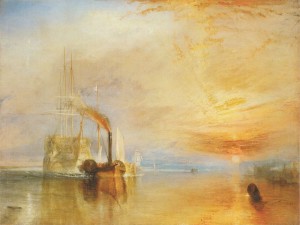A Look At: Romanticism
|
This is the Téméraire, in a famous picture by Turner that is a good view of the Romantic movement as a whole.
Romanticism is a strange word. It is related to ‘Romance’ which is a word for a book not written in Latin. Something written in the Romance languages is likely written for pleasure, rather than for information. This parallels the other use, Romanticism. Romantic images are often designed as emotive, rather than rational. Take the title of this picture, ‘The Fighting Téméraire tugged to her last Berth to be broken up’ – even before seeing it, there is an attempt to alter the viewer’s mood. Romanticism challenges the understandings of the Enlightenment, and attacked Industrialisation. The undoubted damage done by the Industrial Revolution was an easy target for reactionary behaviour. Luddites were not Romantics, but they came from the same understanding – automation put people out of jobs and altered the way that people lived. Romanticism allowed for people to believe in instinct and intuition instead of rational decisions. For the first time a landscape could be seen as wild, spectacular, and admirable. This was so new that instruction in looking at landscapes was needed. The wildness crept into paintings, overpowering the smoother styles of the day with roughness and vigour. Take a look at the paintwork in the accompanying picture – there is little smoothness there. What there is is a sentimental telling of a story. Sentiment here is not necessarily bad; it is very powerful. This is an old wooden ship being dragged to its destruction against the wind, by something rather dirty, and requiring fewer and less skilled men to use. Sentiment was applauded but also reacted against, of course. In fact, it is just part of a movement which has been reviled and supported as any other movement. However, it gave us some fantastic paintings, and (love him or loathe him) Lord Byron. |
